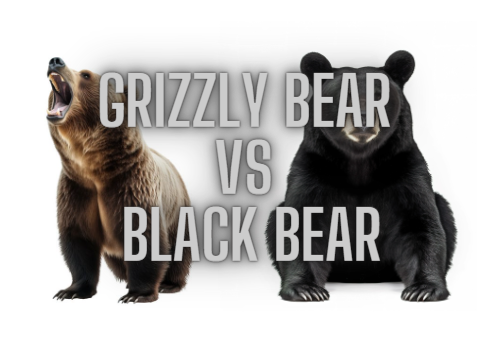In the vast wilderness of North America, encounters between bears are not uncommon. Two iconic species, the grizzly bear (Ursus arctos horribilis) and the black bear (Ursus americanus), stand out as powerful and majestic creatures. In this article, we will explore the distinctive characteristics, habitats, and behaviors of these two bear species and delve into the hypothetical confrontation between a grizzly bear and a black bear.
Grizzly Bear: A Force of Nature
The grizzly bear, also known as the North American brown bear, is a formidable predator that commands respect. It is one of the largest bear species in the world, with adult males weighing between 350 to 680 kilograms (770 to 1,500 pounds) and standing 6 to 7 feet (1.8 to 2.1 meters) tall at the shoulder. Grizzlies have a muscular build, equipped with sharp claws measuring up to 4 inches (10 centimeters) in length.
Grizzly bears inhabit various ecosystems, including mountains, forests, and tundra across North America. They are highly adaptable omnivores, with a diet that includes berries, roots, nuts, fish, insects, and larger prey such as elk or moose. Grizzlies’ thick fur and layers of fat provide insulation in cold climates, allowing them to endure harsh winters.
Known for their strong territorial instincts, grizzly bears display both predatory and defensive behaviors. They are excellent hunters, capable of running at speeds of up to 30 miles per hour (48 kilometers per hour) for short distances. Grizzlies also have a keen sense of smell and hearing, aiding in hunting and detecting potential threats.
Black Bear: A Versatile Survivor
The black bear, the most common bear species in North America, is smaller in size compared to the grizzly bear but still possesses remarkable adaptability and strength. Adult male black bears typically weigh between 100 to 300 kilograms (220 to 660 pounds) and stand about 3 to 4 feet (0.9 to 1.2 meters) tall at the shoulder. They have a stocky build and sharp claws measuring up to 2 inches (5 centimeters) in length.
Black bears have a wide distribution, occupying various habitats, including forests, swamps, and mountains throughout North America. They are opportunistic omnivores and have a highly diverse diet, consuming vegetation, fruits, nuts, insects, small mammals, and sometimes scavenging on carrion. Black bears possess a remarkable ability to climb trees, enabling them to forage for food and seek refuge.
When it comes to behavior, black bears are generally less aggressive than grizzly bears. They have a more solitary nature, although they can tolerate overlapping home ranges. Black bears are adept at avoiding confrontations and typically prefer to flee rather than fight when faced with potential threats.
Hypothetical Battle: Strengths and Strategies
In a hypothetical confrontation between a grizzly bear and a black bear, several factors come into play, including size, strength, aggression, and strategies.
Size and Strength: Grizzly bears are considerably larger and more powerful than black bears. Their larger size and stronger build give them a significant advantage in terms of sheer strength. Grizzlies have more massive claws and a more robust bite force, enabling them to overpower prey or defend themselves against threats more effectively.
Aggression and Temperament: Grizzly bears tend to be more aggressive and territorial than black bears. They are known to assert dominance over their territories and can display defensive aggression when feeling threatened. Black bears, although capable of aggression, are generally more inclined to avoid confrontations and prefer to retreat or climb trees when faced with danger.
Strategies and Tactics: Grizzly bears have a more predatory nature and are skilled hunters. They can chase down prey and use their strength and sharp claws to overpower and subdue larger animals. Black bears, being more agile climbers, may employ tree climbing as a defense mechanism to escape from potential threats, including grizzly bears. They are also adept at bluffing and using vocalizations as a means of communication to avoid physical confrontations.
Final Thoughts
While a hypothetical battle between a grizzly bear and a black bear captivates our imagination, it is important to remember that such encounters are rare and typically avoided in the wild. Grizzly bears possess greater size and strength, making them formidable predators and defenders of their territories. Their aggressive nature and hunting prowess give them an advantage in confrontations.
Black bears, on the other hand, are versatile survivors known for their adaptability and ability to avoid conflicts. They are more inclined to retreat and employ strategies such as climbing trees to escape danger. While smaller and less aggressive than grizzly bears, black bears should not be underestimated as they possess their own unique set of skills and survival techniques.
In the wild, these two bear species have coexisted for centuries, each adapting to their respective environments and playing vital roles in their ecosystems. It is crucial to appreciate and respect these magnificent creatures and their place in the natural world.
In summary, the grizzly bear is larger, stronger, and more aggressive than the black bear. However, the black bear’s agility, adaptability, and avoidance strategies can provide it with advantages in certain situations. Ultimately, the outcome of a hypothetical confrontation between these two bear species would depend on various factors, including the individuals involved, their motivations, and the circumstances of the encounter.

